#white tailed nightjar
Text
BOTD: White-tailed Nightjar

Photo: Chris Harrison
"This rather long-tailed nightjar is found in open grassy or shrubby habitats from Costa Rica across much of northern South America. Both sexes show a distinctive buffy nape. Males have extensive white in the tail, especially visible in flight. Strictly nocturnal; single individuals are most often seen sitting on the ground at night, sallying up to catch flying insects. Listen for the song, which begins with a sharp 'pik' note, followed by a longer whistled 'seeeee,' ascending and then descending."
- eBird
#birds#white tailed nightjar#birds of north america#north american birds#nightjars#birds of central america#birding#bird watching#birdblr#birblr#bird of the day#Hydropsalis cayennensis
62 notes
·
View notes
Text
Semifinals, Poll 5
White-tailed Ptarmigan vs Sickle-winged Nightjar


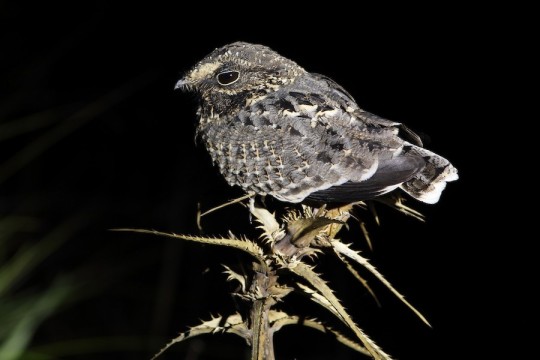
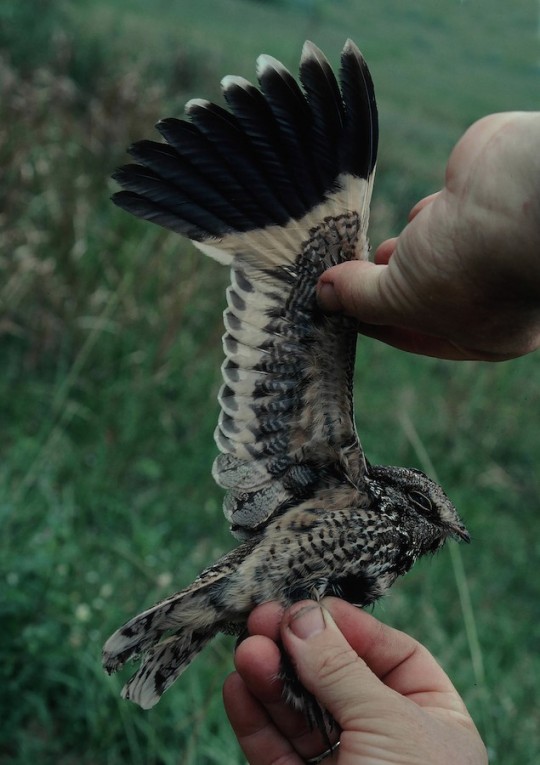
sources under the cut
White-tailed Ptarmigan (Lagopus leucura)
Lagopus is derived from Ancient Greek, meaning "hare foot". This is due to the heavily feathered legs and feet of ptarmigan.
eBird sightings: 5,809; IUCN Redlist Rating: Least Concern
Also known as the Snow Quail, this is the smallest bird in the grouse family. It serves as an indicator species for alpine tundra, and thankfully continues to fill a large range of western North America. The English name "ptarmigan" is Scottish Gaelic in origin, with 'tarmachan' meaning "croaker", referring to the bird's frog-like call. The p- was added due to a mistaken belief the word was Greek in origin, with the thinking being that the word related to 'pteron', "wing".
Sickle-winged Nightjar (Eleothreptus anomalus)
Eleothreptus, from Ancient Greek, means "marsh bred"
eBird sightings: 267; IUCN Redlist Rating: Vulnerable
There is not a lot of information on this bird, as nightjar are already cryptic and the common distribution of this bird hasn't been fully studied. They're currently found in northeastern Argentina, southern Paraguay, and southern Brazil. The Sickle-winged Nightjar shares its genus with a single other nightjar, which is also sparsely distributed across South America.
Images: Ptarmigan (summer - Garrett Hughes, winter - Josiah Verbrugge); Nightjar (wing - Kristof Zyskowski, body - Martjan Lammertink)
#aka: actually idk what thread is in common between these two. they're cute tho#hipster bird main bracket#white tailed ptarmigan#sickle winged nightjar#polls#caprimulgiformes#galliformes
36 notes
·
View notes
Text
Alrighty and HERE ARE OUR CONTENDERS!!!
Tag for the polls: #bird battle
DISCLAIMER - I wrote the round one blurbs when I was very sick and half awake, so if you see any mistakes PLEASE TELL ME! Nicely, obviously, but I want to make sure they sound good for round 2. Thank you!
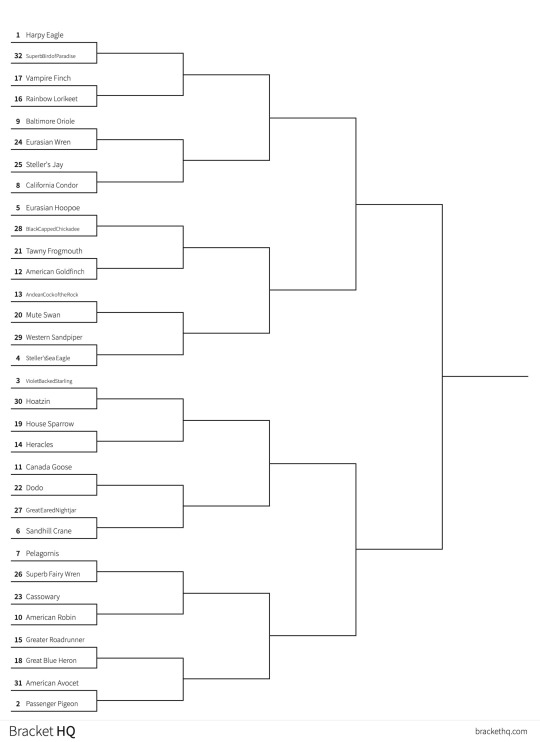

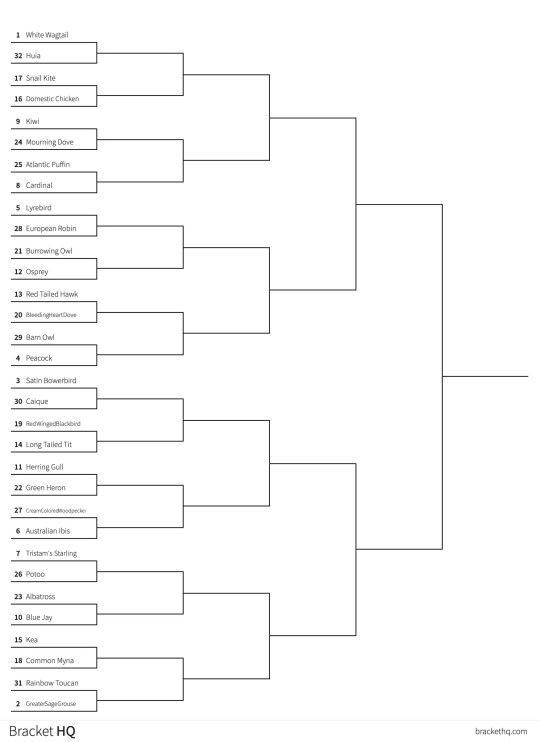

I know there’s a lot of them, but man there’s SO MANY GOOD BIRDS! There were a few times where people didn’t put what specific subspecies for some birds, so sometimes I’d have to choose one. I tried to choose one that represents that bird the best!
I don’t know when the polls will begin, I’m doing some research on the birds so that people can read about them before they vote.
If one of your favs didn’t make it in, don’t worry they’re a winner in my and your heart.
If you are wondering where the Pigeon (Rock Dove) is, THEY ARE THE FINAL CHAMPION! At the end of this bracket, the winner will face off against the mightily popular Rock Dove! Will they be able to beat such a tough challenger? We will see…
Also, a note on how I set this bracket up: I put all the birds in a numbered list and then used a number generator. I think the matchups we got were really interesting.
Full list under the cut
HARPY EAGLE
SUPERB BIRD OF PARADISE
VAMPIRE FINCH
RAINBOW LORIKEET
BALTIMORE ORIOLE
EURASIAN WREN
STELLER'S JAY
CALIFORNIA CONDOR
EURASIAN HOOPOE
BLACK CAPPED CHICKADEE
TAWNY FROGMOUTH
AMERICAN GOLDFINCH
ANDEAN COCK OF THE ROCK
MUTE SWAN
WESTERN SANDPIPER
STELLER'S SEA EAGLE
VIOLET BACKED STARLING
HOATZIN
HOUSE SPARROW
HERACLES
CANADIAN GOOSE
DODO
GREAT EARED NIGHTJAR
SANDHILL CRANE
PELAGORNIS
SUPERB FAIRY WREN
SOUTHERN CASSOWARY
AMERICAN ROBIN
GREATER ROADRUNNER
GREAT BLUE HERON
AMERICAN AVOCET
PASSENGER PIGEON
WALLCREEPER
GREAT TIT
MOA
EASTERN BLUEBIRD
AUSTRALIAN BUSHTURKEY
EMU
MALLARD DUCK
FLAME BOWERBIRD
MANDARIN DUCK
BELTED KINGFISHER
OILBIRD
FAIRY PENGUIN
LESSER FLAMINGO
AUSTRALIAN KESTREL
CARRION CROW
UMBRELLABIRD
LOGGERHEAD SHRIKE
PERUVIAN PELICAN
CALIFORNIA QUAIL
MACGREGORS BOWERBIRD
HARRIS HAWK
COMMON RAVEN
BEARDED VULTURE
PEREGRINE FALCON
ROSY LOVEBIRD
ROSEATTE SPOONBILL
LONG TAILED GRACKLE
AMERICAN WOODCOCK
KAKAPO
BLUE FOOTED BOOBY
RHEA
BEE HUMMINGBIRD
WHITE WAGTAIL
HUIA
SNAIL KITE
DOMESTIC CHICKEN
KIWI
MOURNING DOVE
ATLANTIC PUFFIN
CARDINAL
LYREBIRD
EUROPEAN ROBIN
BURROWING OWL
OSPREY
RED TAILED HAWK
BLEEDING HEART DOVE
BARN OWL
PEACOCK
SATIN BOWERBIRD
CAIQUE
RED WINGED BLACKBIRD
LONG TAILED TIT
HERRING GULL
GREEN HERON
CREAM COLORED WOODPECKER
AUSTRALIAN IBIS
TRISTAM'S STARLING
POTOO
WANDERING ALBATROSS
BLUE JAY
KEA
COMMON MYNA
RAINBOW TOUCAN
GREATER SAGE GROUSE
TURKEY VULTURE
TUFTED TITMOUSE
CRESTED AUKLET
EURASIAN MAGPIE
BUDGIE
SCREECH OWL
WIP-POOR-WILL
SECRETARY BIRD
AUSTRALIAN MAGPIE
CEDAR WAXWING
VICTORIA CROWNED PIGEON
HERMIT THRUSH
COMMON SWIFT
WHITE BELLBIRD
BROWN SKUA
EUROPEAN DIPPER
112 notes
·
View notes
Note
what's "swallow" (as in the bird) in clanmew?
There are three words for Swallow in Clanmew! This is because there are three major species they encounter in this family. But, it must be noted that there are five birds in this Clanmew family, and six new words in this entry.
Clan cats believe that swallows, martins, nightjars, and swifts are all in the same classification.
Yioobeo = Martlet.
Yioobeo is the generic term for these birds. This is best translated into English as a heraldic animal, because these birds are so far apart cladistically that there is no proper term that links them. "Martlets" are all admired by Clan cats because of their incredible flying abilities, and this 'family' is defined by it.
Some of these are counted as songbirds (Fancy), and others as gamebirds (Game). Most are songbirds in some way. However, they are never taken when they are nesting unless it's an emergency. Many martlets create complex social dens, just like a Clan cat, and to attack them near their "camp" is said to invoke the bad luck of another Clan coming to attack yours.
Common House Martin (Delichon urbicum) = Chrir
A white and brown-black bird with a shiny blue-black cape, which tends to construct elaborate nests on human structures. They collect mud and stabilize them against bridges, houses, and caves. They're more solitary compared to other martlets, and produce lots of chicks in a relatively short span of time.
As such, a Chrir is seen as game.
Barn Swallow (Hirundo rustica) = Eeich
The most common swallow to see; a blue-black and white bird with a distinct red face. Their nests have more string, hair, and sticks than a Chrir's, which is pure mud. Eeich return to these nests every year, in the same groups.
Associated with the start of summer and the male's long, streaming tail feathers, the flight of swallows is a joy for Clan cats to witness. They do nearly everything in flight, drinking, eating, and even bathing.
Eeich are considered fancies, or "songbirds," a bird of cultural significance that is dishonorable to hunt.
Sand Martin (Riparia riparia) = Byyrbe
Dull-colored but industrious birds who create "apartment complexes" in sandy riverbanks. This is the swallow that RiverClan sees the most, and they are beloved for eating river midges.
RiverClan cats consider Byyrbe to be fancies, where other Clans see them as game. This is both because RiverClan doesn't typically eat birds to begin with, and their pest-control abilities are highly valued.
Nightjar (Caprimulgus europaeus) = Gyygr
A large, nocturnal bird with a churning, somber sound. Their song is considered mystical. Unlike other birds, you cannot follow a Nightjar's song to the animal that is singing.
This is because the nightjar itself is capable of simple ventriloquism, turning its head as it sings. They also never sing while they're in flight, males perching to camouflage themselves before doing so.
Pair this with the fact that they are ground-nesters who prefer moorland, and it's easy to understand why they're so highly revered in WindClan. It is thought that they were given a song by StarClan itself to help them defend their families, and for this purpose, they are considered Fancies. Dishonorable birds to kill.
Swift (Apus apus) = Wheer
Important to remember that a swift (bird) and the attribute of quickness (prriprra) are two different things in Clanmew! And, if you were wondering, Swiftpaw's name was Wheerpwyyr. He was named for the bird.
This is because the swift is the fastest flying bird in this area, and almost NEVER stops flying. Its legs are so small that they aren't even noticeable while they're in flight. A swift eat, sleeps, and breeds in the air, only ever stopping to lay their eggs. There are even birds who can spend years of their lives without touching the ground.
All martlets are known for being fantastic fliers, but the swift is above all other members of the group in the eyes of Clan cats. To kill a swift is the sort of thing that is never done unless you are explicitly commanded to catch one, as part of some task from your leader or a starvation scenario.
38 notes
·
View notes
Text
Birds of Estolad
Written for @melestasflight
Flora, fauna, geography and environment Masterlist
Other bird posts: Himlad, The March
Other information in the Estolad tag including my environment posts
I love doing general flora and fauna posts but I can’t fit everything in them so I’m trying to make more specific ones as well! please please feel free to send categories to work on with locations! Or any environmental world building asks!
Estolad is a region in Northeastern Beleriand. It was a wide plain located between the river Aros on the west and the river Gelion on the east. It was south of the March of Maedhros and north of the Andram.
We have little canonical information about the environment or ecology of Estolad. For this post, I have primarily used the environmental information for other locations in Eastern Beleriand (though it should be noted that the climate of Ossiriand does differ greatly from the areas between the March and Maglor’s Gap and the Andram). I have also used geographic information and the environmental world building I’ve previously done
Tolkien primarily used plains, prairies and grasslands of North America and parts of Europe and Asia
Like my other similar posts, I’ve included world building notes at the end so it’s not just a list of species! A lot of aspects and species are similar to Himlad but I didn’t repeat all of the same because I didn’t want to get too repetitive! Because of this, I don’t have quite as many birds and some of my notes are a little more frivolous which I apologize for
On the plain: common quail, corn bunting, common buzzard, steppe eagle, hazel grouse, grey partridge, pallid harrier, steppe eagle, black grouse, great grey strike, crested lark, golden eagle (rare), common cuckoo (migratory), lesser kestrel, great bustard, pale backed pigeon, imperial eagle, white throated bushchat
Water birds (on the river banks, in wetlands closer to the Andram and Ossiriand, and in small lakes and ponds): white stork (migratory), common crane, mallard duck, white tailed eagle, water rail, glossy ibis, common loon, gadwell
In trees around the rivers and by the Andram: long eared owls, common bullfinch, grey wagtail, mountain accentor (in the north and south of the region), common hoopoe (migratory), little owl, grey headed woodpecker, common raven, merlin, common golden oriole, common nightjar
World building notes:
-The Noldorin host of Estolad rely on birds for food (meat and eggs), feathers (for down, quills, etc) and companionship/aid
--Among the Noldor in Estolad, birds of prey are used for hunting. The species most commonly used are the pallid harrier and the steppe eagle
-The small population of green elves in Estolad do not eat birds however they do eat eggs of some species including ones they’ve domesticated. They also use feathers in and on clothing and with down.
-Birds are common in the folklore, language and art of both elven peoples of Estolad. Though most of the established Noldorin lore originated before their settling there, some tales and phrases and art do develop among their host. Some of these develop in connection to the lore and traditions of the green elves there
One such tradition are styles of paintings of birds, similar to the bird and flower or Huaniaohua in the real world. These developed in part inspired by spoken poetry and song by the green elves, particularly those related to their spring gatherings.
-The green elves of Estolad likewise have an abundance of lore and beliefs about the animals around them including many about birds and symbolic meaning given to species. White storks for example are symbolic of approaching death, winter or other natural changes of a somber nature. Common golden orioles are signifiers of late summer and early autumn. They are associated with the increased pressure to forage and store food for the winter and their image often appears on the cloth bags that hold certain items
-There is a tiny lake near where the initial settlements by Amrod and Amras’s host was. During the first spring, baby cranes were seen on the water. Some of the advisers and higher ups became very fond of the little family.
-Estolad was also inhabited by humans. Several cultures lived there for a time after coming west from over the Ered Luin. Just like other aspects of the environment and life of Estolad, the birds of Estolad entered the lore and knowledge of the Edain hosts, combining and joining with the lore and knowledge from their old homes beyond the Ered Luin.
Note: I want to go more in to their relationship of the humans here with the environment, including with birds on another post so I can do that in more depth 
25 notes
·
View notes
Text
The Parable of the Mustard Seed (icon)
“Jesus put before them another parable: "The kingdom of heaven is like a mustard seed that someone took and sowed in his field; it is the smallest of seeds, but when it has grown it is the greatest of shrubs and becomes a tree, so that the birds of the air come and rest in its branches." -Matthew 13:31-32
Recent icon of this passage by Kelly Latimore:
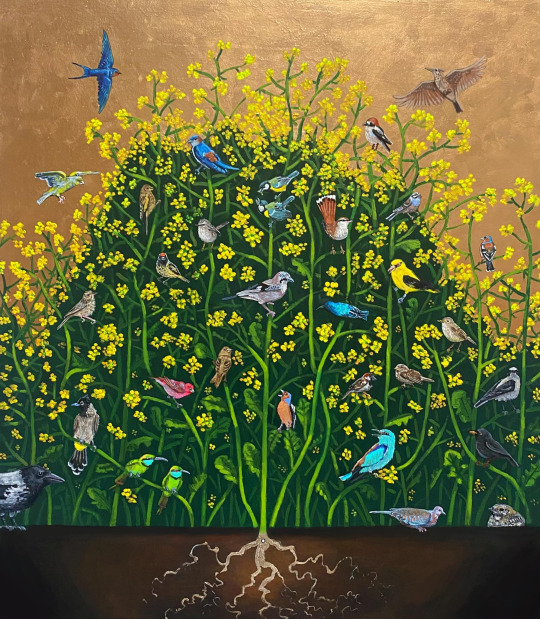
+++
Commenary by Kelly Latimore:
Jesus' parables are one of the ways Jesus trains his disciples. The parables, like the sermon on the mount, have always been crucial for the church to imagine the kind of community it is called to be. We discover again and again that Jesus' parables significance points to everyday life. The parables are meant to be lived.
The original audience may have been perplexed by this story. They would have known that no-one would intentionally plant a mustard shrub. In fact, the Jewish Mishnah forbade the growing of mustard seeds in the garden because they were 'useless annoying weeds'. In the Hebrew Scriptures the "birds of the air" can be a reference to Gentiles/Non-Jews, the foreigner.
This parable suggests that the kingdom of heaven is available to everyone. Even those who may be considered outsiders or not "Worthy". Jesus is calling us to see the significance in the insignificant. The parables of the kingdom of heaven make clear that the kingdom of heaven is not "up there". Through the parables Jesus is teaching us to "be for the world the material reality of the kingdom of heaven brought down to earth." As Jesus is himself the parable of the father so the church is meant to be the parable of Christ. A people in space and time welcoming the outcast, the foreigner, and the stranger. These kind of communities will look like unwanted weeds to the world, or even to other christians. However, this may be exactly the church Jesus is asking us to embody.
Prints, Digital Downloads, and Calendars available
All of the birds in this icon are native to the Holy Land. Birds in the icon: Palestine Sunbird, Scrub Warbler, Common Rosefinch, Laughing dove, Barn Swallow, House Sparrow, Fire-Fronted Serin, Red- Rumped Swallow, Rufous-tailed Scrub Robin, Woodchat Shrike, European Greenfinch, Tree Pipit, Nubian Nightjar, Northern Wheatear, Green Bee Eater, Eurasian Golden Oriole, European Roller, Eurasian Jay, Great Tit, Hooded Crow, Eurasian Blackbird, Common Chiffchaff, Rock Bunting, Crested Lark, and White Spectacled Bulbul.
https://www.facebook.com/photo/?fbid=1006593093924270&set=a.437194030864182 https://www.facebook.com/kellylatimoreicons
6 notes
·
View notes
Text
White-throated Nightjar
Large nightjar of the eastern ranges of Australia, most commonly seen in the late evening when hawking over water or over clearings in forests. Primarily dark gray, with extensive barring. All-dark tail and fairly plain wing evident in flight. Song is a unique bubbling that rises in pitch and frequency.

Also lmk if I should keep posting drawing w them, I'm not sure
5 notes
·
View notes
Text
Apodiformes Bracket Matchups
Now that the Shorebirds Bracket is over (congrats to the little auk!), I'll be setting up the Apodiformes bracket, created from your submissions! The first-round matchups will be:
Bumblebee hummingbird vs Bee hummingbird
Broad-tailed hummingbird vs Rufous hummingbird
Calliope hummingbird vs Vervain hummingbird
Costa’s hummingbird vs Anna’s hummingbird
Ruby-throated hummingbird vs Red-tailed comet
Black-tailed trainbearer vs Long-tailed sylph
Hispaniolan mango vs Black-throated mango
Horned sungem vs Purple-throated carib
White-booted racket-tail vs Sword-billed hummingbird
Glowing puffleg vs Rainbow starfrontlet
Violet sabrewing vs Crowned woodnymph
Red-billed streamertail vs Black-bellied hummingbird
Purple-throated mountaingem vs Fiery-throated hummingbird
Bohm’s spinetail vs Chestnut-collared swift
Common swift vs Chimney swift
Whiskered treeswift vs Crested treeswift
I'm not certain when I'll be finished making the visuals and fact blurbs, but I'll make an announcement when I am. In the meantime, I will be opening up the submissions form for our bracket after this, which will be a sort of sequel: non-Apodiformes Strisores birds, abbreviated to "Other Strisores." This includes nightjars, owlet-nightjars, oilbirds, potoos, and frogmouths.
Here is the link
7 notes
·
View notes
Note
Trick or tweet! 💕🐦

You get: a white-tailed nightjar!
45 notes
·
View notes
Text
Semi-Finals!
American Dipper vs Blakiston's Fish Owl
Oilbird vs African Penguin
Purple Honeycreeper vs Bluethroat
Japanese Paradise Flycatcher vs Pink Robin
White-tailed Ptarmigan vs Sickle-winged Nightjar
Whiskered Auklet vs Palawan Peacock-pheasant
Short-tailed Pygmy Tyrant vs Oriental Bay-Owl
Bat Hawk vs Groove-billed Ani
This post will be updated with poll links once they go live!
#hipster bird main bracket#masterpost#yall we are down to 8!!!#i was supposed to make use of my rain day and start on these polls but as of yet Ive just been playing Flight Rising lol
46 notes
·
View notes
Text
Clan Names: Bird Additions
Cardinal - A mostly or completely bright red cat, can refer to a specific patter of red with a black mask, obnoxious or noticeable. Used mostly by ThunderClan and ShadowClan.
Cuckoo - A gray furred cat with white flecks, a cat with long legs, someone who is bold or aggressive. Used by all clans equally.
Loon - An alternative to duck with the same meaning
Grouse - A brown and black cat, usually someone is speckled with brown. Used mostly by WindClan.
Tern, Pelican - Alternatives to gull with the same meaning
Hummingbird - A vibrant or pretty cat, someone who is fast or always moving, a runt, a small cat. Used by everyone but ShadowClan.
Harrier - an alternative for Kite with the same meaning
Limpkin - A long-legged cat, brown cat with white freckles, an alternative to crane or heron.
Nightjar - A predominantly or all black cat, someone who talks a lot. A popular ShadowClan name.
Pintail - A cat with a thin tail or a thin coat, a cat with gray nose and pad leather. Predominantly a RiverClan name.
Ptarmigan - A small and round cat, someone with soft fur, a rarely used name due to its length.
#names of the clans#naming conventions#warrior cats#erin hunter#fanfiction#fanfic#warrior cats fanfic#erin hunter warriors#worldbuilding#the cats of strelles#strelles the greenwood empire
5 notes
·
View notes
Text
Bestial Human Information for medical treatment purposes

This information is something only the Infirmary needs to know to better care for bestial human students but given Sin is a nurse trainee and was curious he swiped this info on Damián,Sable,Ignacio,Eric,Niyol,Reno,and himself one day when saw records cabinet in Infirmary open.
However Sin is shocked what he read the staff has placed on some of his friends and himself. This explains his housewarden's fear of the Infirmary that he refuses to talk about.
Bestial Human Info
Given information on these bestial humans note reviewed by a infirmary staff member for clearer understanding.
●
Name: Damián Reed Delgado
Age: ?? (Can't seem to figure out)
Gender: Male
Dorm: Serendipia
Status: Housewarden
Beast: White-Tailed Stag Deer 75%
Behavior: Normalish but erratic behavior has been reported
Tranquilizer?: Always due to Safety Reasons
Human Features: Arms,Hands,Upper Half Torso,Head
Beast Features: Waist,Pelvic Area,Legs,Ears,Antlers,Tail,Back has fur area where Tail connects
Note: Lives by a natural wilderness type lifestyle. Would prefer natural medicine over man-made or magical made first when treated. Has refused medical treatment before so may have to tranquilize to treat however is a always tranquilize one so do so regardless I assume. We may need look into another method as the tranquilizer count on his record is a concerning health risk. Has no one checked if this student is ok? Will request he be seen immediately after this note review.
●
Name: Sable Asra
Age: 18
Gender: Male
Dorm: Serendipia
Beast: Great-Eared Nightjar Bird 60%|(Sin scratched other half out due to wanting to keep Sable's secret he now knows to himself)
Behavior: Very Normal
Tranquilizer?: No
Human Features: Hands,Arms,Torso,Pelvic Area,Head,Ears
Beast Features: Wings,Upper Calves,Legs,Feet,Tail
Note: Pretty much behaves like normal Beasthuman. Interesting mix of a bestial human he is. Approach first when arriving to dorm for a situation due to no threatening behavior.
●
Name: Ignacio Desta Luna
Age: 19
Gender: Male
Dorm: Serendipia
Beast: Longhorn Bull 80%
Behavior: Mixed but nothing concerning reported yet.
Tranquilizer?: No unless on a rampage if does that.
Human Features: Hands,Arms,Upper Torso,Head
Beast Features: Waist,Pelvic Area,Legs,Feet,Tail,Horns
Note: Is very docile as nothing been reported but that could always change. Regularly comes for check up and is very kind despite his dangerous look. Monitor.
●
Name: Eric Salazar(This is a named npc student who will be in the npc post)
Age: 18
Gender: Male
Dorm: Serendipia
Beast: Snow Leopard 56%|White Tiger 44%
Behavior: Very Instinctual yet also Normalish aswell
Tranquilizer?: Always due to Safety Reasons
Human Features: Upper Arms,Torso,Waist,Pelvic Area,Head
Beast Features: Hands,Lower Arms to Elbow,Legs,Feet,Ears,Tail,Grows Whiskers but Cuts them Short
Note: Haven't ever come to Infirmary so only this info is known. Nothing been reported but given beasts he is a mix of normal high concern of violent nature. Need to gain more info.
●
Name: Niyol Nyx
Age: ??
Gender: Male
Status: NRC Staff Member
Beast: Snowy Owl 80%
Other: Fae 20%
Behavior: Very Normal and Docile
Tranquilizer?: No
Human Features: Head,Torso,Pelvic Area,Ears & Horns are of Fae type
Beast Features: Wings with arms & hands fused into them,Legs,Feathers growing within hair,Eyebrows are feathers not hair,Chest has feathers instead of hair,Tail,
Note: Headmage provided this info and asked to not pry anymore into this staff member.
●
Name: Reno Quimera
Age: ??
Gender: Male
Dorm: Ignihyde(Transfered from Serendipia)
Beast: Goat 85%
Behavior: Normal
Tranquilizer?: No
Human Features: Hands,Arms,Upper Torso,Head
Beast Features: Waist,Pelvic Area,Legs,Feet,Tail,Ears,Horns
Note: Very different then other Goat bestial humans. Doesn't act like a goat at all. Nothing concerning except his random misconduct of flirting with nursing staff.
●
Name: Sin Cueva
Age: ??
Gender: Male
Dorm: Serendipia
Beast: Vampire Bat 75%
Behavior: Very Disturbing is written
Tranquilizer?: Won't work must weakened with Light magic,Deafen Ears,and Blindfold Eyes. Use Heavy Force.
Human Features: Head,Upper Torso,Waist
Beast Features: Wings with arms and hands fused in,Legs,Ears,Tail,Pelvic Area
Note: Highly Dangerous proceed with caution. Have been instructed to use various methods to subdue. Despite this he comes to Infirmary often as wants to be a nurse? Conflicting if who gave information is paranoid,biased,or something. This student has been very kind when he is here and curious how we do things. Please use your own judgment when treating this student. We shouldn't be hurting him if he needs help...
●
#twst fandorm#serendipia#oc lore#dorm lore#how Bestialhumans are treated#Damián's tranquililazation record is 17 by NRC security/infirmary for erratic behavior or refusal of treatment#these are mostly from his 1st year#i can explain in ask about this if any wanna know otherwise only time it will be#count will increase in story tho
2 notes
·
View notes
Text
Rwanda Gorilla Safari: A Superb Opportunity To View The Mountain Gorillas
Little and compact, Rwanda is overflowing with untamed wildlife, amazing national parks, and superb scenes. The gorilla-chimpanzee trekking in Rwanda gives you an extraordinary chance to explore the national treasure. How to catch a glimpse of the typical safari creatures? Embarking on a Rwanda gorilla safari tour is imperative
Trekking to see chimpanzees and gorillas is without a doubt a feature of the Rwanda gorilla safari tour. It ensures a close encounter with the primates present in the various national parks and jungles. It is an immersive experience.
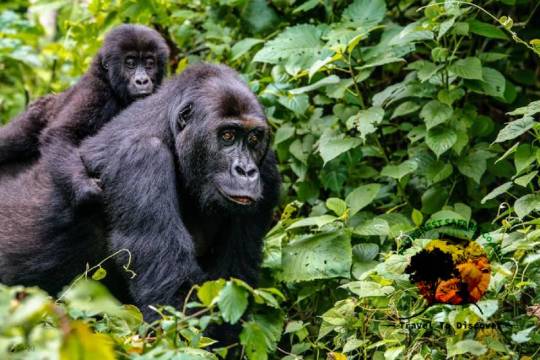
This remarkable journey will transport you to the picturesque savannah reserve in Rwanda. It is where you will encounter a diverse array of wildlife, including leopards, elephants, buffalos, zebras, lions, black and white rhinoceroses, panthers, giraffes, and an abundance of antelope species such as topi, impala, and defassa waterbuck.
Rwanda boasts three primary wildlife destinations: Volcanoes National Park, Nyungwe Forest National Park, and Akagera National Park. All of them are home to a wide range of fauna. Among these, Rwanda stands as one of the three countries where endangered mountain gorillas can be found. Observing these magnificent creatures in their native environment is an incomparable wildlife encounter. Additionally, visitors have the opportunity to track habituated chimpanzees and golden monkeys, similar to the thrilling gorilla trek. Rwanda's diverse habitats provide a sanctuary for numerous species, including mountain gorillas, chimpanzees, golden monkeys, hippos, giraffes, zebras, leopards, crocodiles, and over 600 bird species.
Volcanoes National Park is renowned for its diverse population of mountain gorillas, with several hundred individuals residing there. The park offers the opportunity to observe a dozen habituated gorilla groups, and a total of 96 tracking permits are issued daily for this purpose. In addition to gorillas, the park is home to various other wildlife species such as the golden monkey, elephant, buffalo, giant forest hog, bushpig, bushbuck, and black-fronted duiker. Bird enthusiasts will find around 200 bird species, including 16 Albertine Rift Endemics, although birdwatching logistics can be challenging in this area.
Nyungwe Forest National Park, on the other hand, boasts the highest level of biodiversity in Rwanda. It safeguards over 1,050 plant species and supports a rich array of wildlife, including 85 mammal species, 310 bird species, 32 amphibian species, and 38 reptile species. Among the park's highlights are its thirteen primate species, such as chimpanzees, Ruwenzori colobus monkeys, L'Hoest's monkeys, and various other monkey species. Nyungwe is also renowned as a premier destination for forest bird watching in Africa, attracting dedicated birdwatchers from around the world.
Akagera National Park is a traditional African savannah reserve where visitors have the opportunity to spot the Big Five. While buffaloes and elephants are commonly sighted, leopards are frequently observed during night drives. The presence of lions and black rhinos is also steadily increasing. In addition to these magnificent creatures, the park is home to a diverse range of wildlife including Maasai giraffes, Burchell's zebras, warthogs, olive baboons, vervet monkeys, hippos, impalas, Defassa waterbuck, bushbucks, common duikers, elands, topis, Bohor reedbuck, oribis, roan antelopes, klipspringers, and the elusive semi-aquatic sitatungas. Night drives often offer sightings of spotted hyenas, genets, civets, white-tailed mongooses, bushbabies, elephant shrews, as well as various species of owls and nightjars.
Combine game viewing in the National Park with its varied wildlife & gorilla trekking in Rwanda could make your journey exciting. It could be a superb opportunity to view the mountain gorillas and experience Africa’s largest protected wetland. To get the best of Rwanda gorilla safari tour including bird watching, local community tour, forest walk & experiencing the wilderness contact Nature Nest safaris at +256 777131912 or visit https://www.naturenestsafaris.com/ today!
1 note
·
View note
Text
Birds of Dor-lómin
I have decided to make two posts at least for the birds of Hithlum, this one and one for Mithrim and greater Hithlum
As I take inspiration from several European and Asian countries for the environment of Dor-lómin, the species here reflects that however to the best of my ability it is ecologically consistent. Obviously this will not be a complete list and I will go back to it!
And as always requests are open! I’m also always willing to put together ecological world building based on specific real locations!
Flora, fauna, geography and environment of Arda Masterlist
Note: I use Hadorian here to refer to the folk of Hador and of Marach including cultural practices that might predate Hador himself
The eastern mountains and forests around Húrin’s house: hazel grouse, brambling, northern wryneck, common buzzard, Zitting cisticola, grey headed woodpecker, black redstart, grey heron, common quail, great spotted woodpecker, dusky thrush, white winged crossbill, Bohemian waxwing, ring ouzel, tawny owl, common raven
The western border and Firth of Drengist: horned grebe, osprey, black crowned night heron, little gull, black tern, great white pelican, common kingfisher, common starling, little ringed plover, rocky pipit, white tailed eagle
Note: many of the mountain, sea and wetlands birds here are incidental species occurring in Dor-lómin because of migration or other factors. This is also true of some of the species listed for the eastern mountain borders.
The fields and open lands: Greylag goose, corn bunting, little owl, gadwall, mallard duck, wood lark, bearded reedling, hedge warbler, twite, common grasshopper warbler, yellowhammer, greater scaup (migratory), nightjar, stone curlew, barn owl, black headed bunting, whinchat, little grebe, goldfinch, blue throat
Throughout: common wood pigeon, fieldfare, hobby (migratory), common crane, mute swan, house sparrow, merlin, common buzzard (primarily in the Southern mountains), black woodpecker, gryphfalcon
World building notes:
-The people of Hador keep ducks, geese, chickens and pigeons including a species like passenger pigeons. They are the only group of Atani in Beleriand that has a practice of keeping birds primarily for eggs as well as meat and who uses eggs in cooking semi frequently. The Haladin, B��orians, Drúedain and other groups do eat eggs though not usually chicken eggs and do not often use them as ingredients in baking (although there are some Bëorian dishes that involve bread with quail eggs)
-Hadorian food is a combination of farming and agriculture and hunting and foraging. Grouse, pheasant and wild ducks are sometimes caught for food
-Sea birds are relatively rare but can be seen in western Dor-lómin near the Firth of Drengist and the border to Nevrast. The northern Sindar who live in western Hithlum including western Dor-lómin keep oral records of the presence and appearance of sea birds and mentions of them appear occasionally in song
-Feathers of geese are designs associated with the Hadorian midwinter festival. They are sometimes worn but more commonly embroidered or painted.
-The northern Sindar by the caves of Androth paint birds on the cave and cliff walls, using pigments made from minerals, bark and sometimes shells. Herons, gulls and starling shapes are the most common.
-Random character HC: Sador’s favorite animals to carve are birds especially ground birds. Some of these he even paints or polishes when he has the time.
16 notes
·
View notes
Text
The Parable of the Mustard Seed (new icon)
A new icon by Kelly Latimore, followed by his commentary.
“He put before them another parable: "The kingdom of heaven is like a mustard seed that someone took and sowed in his field; it is the smallest of seeds, but when it has grown it is the greatest of shrubs and becomes a tree, so that the birds of the air come and rest in its branches." -Matthew 13:31-32
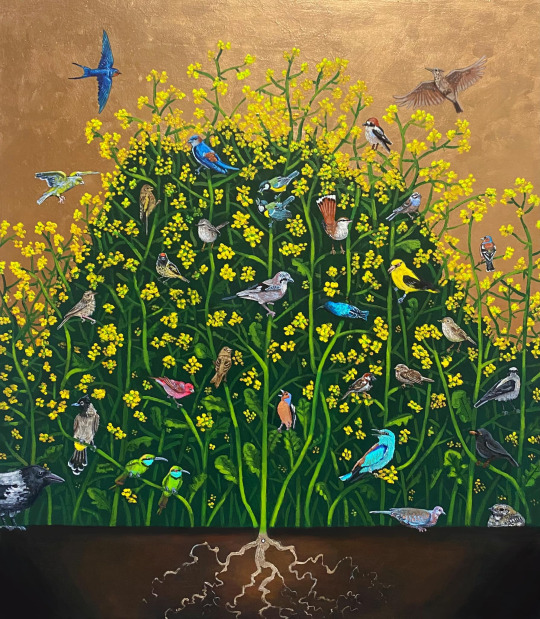
+++
Commentarry by Kelly Latimore, from his FB page at https://www.facebook.com/photo/?fbid=963990678184512&set=a.437194030864182
Jesus' parables are one of the ways Jesus trains his disciples. The parables, like the sermon on the mount, have always been crucial for the church to imagine the kind of community it is called to be. We discover again and again that Jesus' parables significance points to everyday life. The parables are meant to be lived.
The original audience may have been perplexed by this story. They would have known that no-one would intentionally plant a mustard shrub. In fact, the Jewish Mishnah forbade the growing of mustard seeds in the garden because they were 'useless annoying weeds'. In the Hebrew Scriptures the "birds of the air" can be a reference to Gentiles/Non-Jews, the foreigner. This parable suggests that the kingdom of heaven is available to everyone. Even those who may be considered outsiders or not "Worthy". Jesus is calling us to see the significance in the insignificant. The parables of the kingdom of heaven make clear that the kingdom of heaven is not "up there". Through the parables Jesus is teaching us to "be for the world the material reality of the kingdom of heaven brought down to earth." As Jesus is himself the parable of the father so the church is meant to be the parable of Christ. A people in space and time welcoming the outcast, the foreigner, and the stranger. These kind of communities will look like unwanted weeds to the world, or even to other christians. However, this may be exactly the church Jesus is asking us to embody.
Prints, Digital Downloads, and Original Icon available: kellylatimoreicons.com
https://www.facebook.com/kellylatimoreicons
All of the birds in this icon are native to the Holy Land. Birds in the icon: Palestine Sunbird, Scrub Warbler, Common Rosefinch, Laughing dove, Barn Swallow, House Sparrow, Fire-Fronted Serin, Red- Rumped Swallow, Rufous-tailed Scrub Robin, Woodchat Shrike, European Greenfinch, Tree Pipit, Nubian Nightjar, Northern Wheatear, Green Bee Eater, Eurasian Golden Oriole, European Roller, Eurasian Jay, Great Tit, Hooded Crow, Eurasian Blackbird, Common Chiffchaff, Rock Bunting, Crested Lark, and White Spectacled Bulbul.
6 notes
·
View notes
Text
Woodcocks have the brightest white feathers
These surprise findings, by a team led by an Imperial College London scientist, suggest there is much to learn about how birds that are most active at night or at dawn and dusk communicate.
Birds that are most active during the day often have colourful plumages, which they use to communicate information with each other. Birds that are most active at dawn and dusk or at night (‘crepuscular’), such as nightjars and woodcocks, tend to have less showy plumage, as while sleeping during the day they need to be camouflaged to avoid predators.
Rather than using showy plumages, it was thought that birds active during low light conditions instead used sounds or chemicals to communicate. However, many have bright white patches, which could be used in environments with very little natural light for communication if these are reflective enough.
The Eurasian woodcock, Scolopax rusticola, is primarily mottled brown, but has patches of white feathers on the underside of its tail. This means it only shows these patches when raising its tail or during courtship display flights.
However, as they are crepuscular, and so most active during low light, these white patches need to reflect as much light as possible to attract attention. To investigate how they might do this, the team studied the white tail feathers of Eurasian woodcock specimens from a collection in Switzerland.
They used specialised microscopy to image feather structure, spectrophotometry to measure the light reflectance, and models to characterise how photons of light interact with structures inside the feather. They were surprised to find the reflectance measurements showed the feathers reflected up to 55% of light — 30% more light than any other measured feather. The results are published today in Royal Society Interface.
Lead researcher Jamie Dunning, from the Department of Life Sciences (Silwood Park) at Imperial, said: “Bird enthusiasts have long known that woodcocks have these intense white patches, but just how white they are and how they function has remained a mystery. From an ecological perspective the intensity of the reflectance from these feathers makes sense — they need to hoover up all the light available in a very dimly lit environment, under the woodland canopy at night.”
Individual feathers are made of a central stem with protrusions called rami forming the bulk of the structure. The rami are held together by round Velcro-like ‘barbules’.
The team found that in the woodcock’s white tail feathers the rami are thickened and flattened, which both increases the surface area for light to bounce off, while also making it less likely light will pass between the feather barbs without being reflected.
There are two main ways surfaces are reflective. ‘Specular’ reflection is when light bounces off a smooth surface, like a mirror. ‘Diffuse’ reflectance scatters light rays in different directions. The thickened rami were found to be made up of a network of keratin nanofibers and scattered air pockets. This creates lots of interfaces that can scatter light, increasing the feathers’ diffuse reflectance.
Analysis of the feathers showed one final trick up the woodcock’s sleeve: the rami and barbules in the white woodcock feathers are arranged to create a venetian-blind-like effect that further enhances the surface area, by sitting at the optimum angle for light reflectance.
Principal Curator of Birds at the Natural History Museum Dr Alex Bond said: “This research is a brilliant combination of using museum specimens and cutting-edge tools to try and understand this phenomenon. Being able to see whether closely related species or species with similar ecology also had these incredibly white feathers was a key bit of figuring out the story.”
0 notes